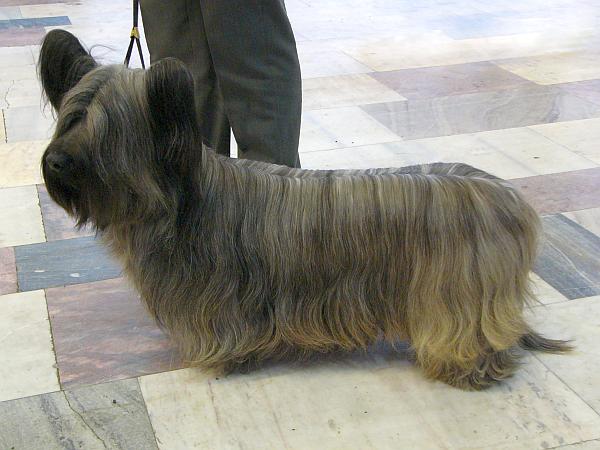
The Skye Terrier, a long haired terrier, got its name because the dog breed was originally found on the Isle of Skye in Scotland. Some say that shipwrecked Spanish ships in the 16th century delivered surviving Maltese dogs who were mated with the local terriers on the island to produce the Skye bred. There were only around 30 born in the United Kingdom in 2005, according the Encyclopedia of Dog Breeds, and may become extinct within 40 years.
Long Haired Terrier
This long haired terrier has a topcoat that’s long and hard. The topcoat covers a soft, short undercoat. Its eyes and forehead are covered by the hairs on its head. The Skye Terrier comes in several variety of colors, including black, light and dark grey, blue and blonde. Since they are long haired terriers, their coats need to be brushed regularly or they will become matted. The males typically weights from 35-40 pounds, and the female are lighter at 25-30 pounds.
Strong Willed and Affectionate
Their disposition is somewhat independent minded and willed. They are affectionate and even devotional towards its owner and its family, can Skye terriers can be protective. They can be wary of strangers and other dogs. Their lifespan is about 10-14 years.
Because of their size and the fact that they need less exercise than other dogs their size, Skye terriers are regarded as good apartment dogs.
Bred to Hunt
Sky Terriers were originally bred to hunt out small animals such as foxes, badgers and otters that threatened the livestock of farmers in Scotland. The American Kennel Club recognized the Skye terrier as an official breed in 1887.
In terms of health Sky terriers are susceptible to health conditions such as glaucoma, ulcerative colitis, and allergies.
These long haired terriers do have strong disposition and on the fearless side, but they are also affectionate, loyal and devotional to its family. They would make good family pets. If you have other small non-canine pets, be cautious, since Skye terriers were originally bred to hunt these type of small animals, and their instinct may kick in. They don’t need too much exercise but they do need to be taken on a daily walk.


